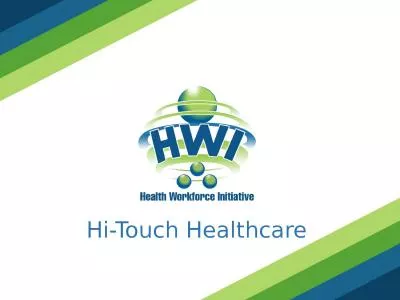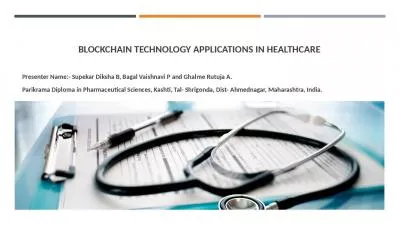PPT-Introduction to Healthcare Information Technology
Author : giovanna-bartolotta | Published Date : 2018-12-15
Chapter Five Medical Business Operations Objectives Define frequently used healthcare terms Identify and describe the functions of certain healthcare departments
Presentation Embed Code
Download Presentation
Download Presentation The PPT/PDF document "Introduction to Healthcare Information T..." is the property of its rightful owner. Permission is granted to download and print the materials on this website for personal, non-commercial use only, and to display it on your personal computer provided you do not modify the materials and that you retain all copyright notices contained in the materials. By downloading content from our website, you accept the terms of this agreement.
Introduction to Healthcare Information Technology: Transcript
Chapter Five Medical Business Operations Objectives Define frequently used healthcare terms Identify and describe the functions of certain healthcare departments Describe the uses for clinical software. Person’s Name Dipankar Khasnabish. Name of Meeting Bengal Chamber of Commerce & Industries. Date and Year 1. st. August, 2014. 0.9 bed . / 1000 . population. An addition of 1 bed / 1000 will need around USD 80 B . 11.11 . Identify . methods and types of data collected in healthcare.. Databases. Electronic collection of information. Stored and sorted by fields (such as name, address, date of service, etc.). Examples:. 11.11 . Identify . methods and types of data collected in healthcare.. Databases. Electronic collection of information. Stored and sorted by fields (such as name, address, date of service, etc.). Examples:. 11.11 . Identify . methods and types of data collected in healthcare.. Databases. Electronic collection of information. Stored and sorted by fields (such as name, address, date of service, etc.). Examples:. Chapter One. Introduction to Healthcare IT. About the Presentations. The presentations cover the objectives found in the opening of each chapter.. All chapter objectives are listed in the beginning of each presentation.. Course ContentThe Scope of the EMR/HITMarketMobile TechnologyAdvancesIncentives in the HIT MarketThe Role of Certified Healthcare IT ConsultantsReview Quiz and Resource Links PageThe Scope of the EMR/ Technology Pediatric HealthCare Provider Informational ResourceSEPTEMBER 2020Pediatric Health Information Technology Pediatric HealthCare Provider Informational ResourceONC2Table of ContentsForeword4I Associate in Science Degree in Medical InformaticsThis program is an interdisciplinary program which combines courses from Information Technology Health Information Technology and Biology It is the st The Desired Brand Effect Stand Out in a Saturated Market with a Timeless Brand The Desired Brand Effect Stand Out in a Saturated Market with a Timeless Brand The Desired Brand Effect Stand Out in a Saturated Market with a Timeless Brand What to Expect in this Presentation. Overview of the impact of information and communication technologies on the delivery of healthcare. Overview of how communication technologies influence messages in everyday encounters. From Data Quality to Improved Access to care . Jalal Al Alwan, PhD. Healthcare Quality Analytics Consultant. Disclaimer. “The opinions expressed in this presentation and on the following slides are solely those of the presenter and not necessarily those of Johns Hopkins Aramco Healthcare (JHAH). . Presenter Name:- Supekar Diksha B, . Bagal. Vaishnavi P and . Ghalme. Rutuja A.. Parikrama Diploma in Pharmaceutical Sciences, . Kashti. , Tal- . Shrigonda. , . Dist. - Ahmednagar, Maharashtra, India..
Download Document
Here is the link to download the presentation.
"Introduction to Healthcare Information Technology"The content belongs to its owner. You may download and print it for personal use, without modification, and keep all copyright notices. By downloading, you agree to these terms.
Related Documents

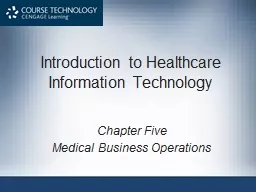
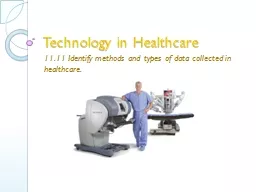
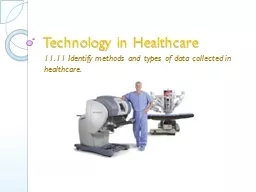
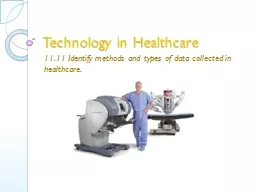
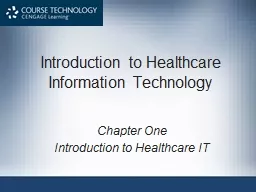
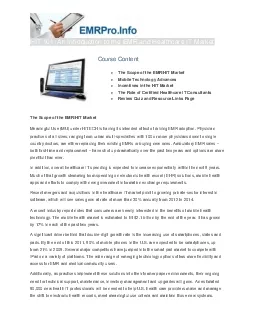
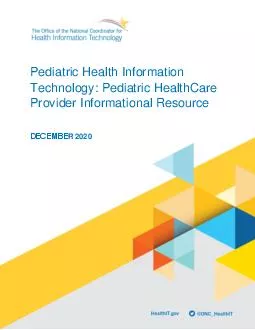
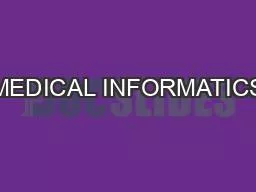
![[DOWLOAD]-Information Technology Essentials: An Introduction to Information Technology](https://thumbs.docslides.com/980292/dowload-information-technology-essentials-an-introduction-to-information-technology.jpg)
![[DOWLOAD]-Healthcare Information Technology Exam Guide for CompTIA Healthcare IT Technician](https://thumbs.docslides.com/985050/dowload-healthcare-information-technology-exam-guide-for-comptia-healthcare-it-technician-and-hit-pro-certifications.jpg)
![[PDF]-Information Technology Essentials: An Introduction to Information Technology](https://thumbs.docslides.com/989832/pdf-information-technology-essentials-an-introduction-to-information-technology.jpg)
